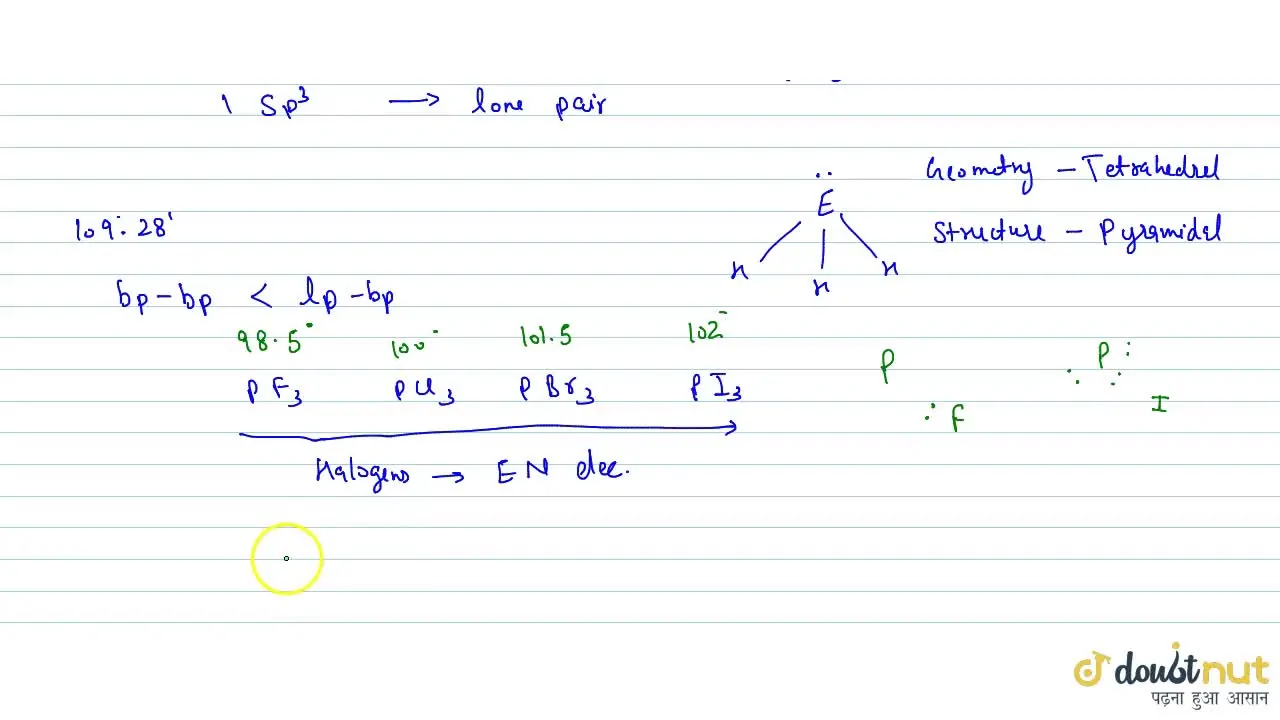REACTIVITY TOWARDS HALOGEN - TRIHALIDES
Reactivity Towards Halogen - Trihalides
Halogens such as bromine, chlorine, and iodine have characteristics that empower them to respond with different elements to shape significant salts such as sodium chloride.
Characteristics of Halogens
Group 17 has elements like fluorine, chlorine, bromine, iodine, and astatine; it is also termed as the halogen group. At normal room temperature, fluorine is in the form of yellow gas, chlorine is a light green gas, bromine is a red fluid, and iodine is a purple solid. Astatine is a radioactive component and exists in nature just in tiny amounts. All the halogens exist as diatomic molecules. They have high ionisation energies and structure the most electronegative group of elements. Their electron design, ns2np5, allows them to react with Group 1 and 2 metals easily; every halogen tends to get one electron, and the Group 1 and Group 2 elements each will, in general, lose a couple of electrons, respectively. Halogens consequently react most vigorously with Group 1 and Group 2 metals of all primary group elements.
Reactivity of Group 15 Elements Towards Halogens:
Group 15 elements react with halogens to form trihalides and pentahalides with the general configuration EX3 and EX5.
2E + 5X2 → 2EX5
Halogen Pentahalide
2E + 2X2 → 2EX3
Halogen Trihalide
Example: PF3, NF3 AsF3, SbF3 and BiF3 are trihalides.
The trihalides of the particular elements, except those of nitrogen, are consistent. Phosphorus, arsenic and antimony shape pentahalides considering the closeness of empty d orbitals in their outermost shells. Nitrogen does not form pentahalides as a result of the non-appearance of a d orbital in its outermost shell. Pentahalides are more covalent than the relating trihalides. Besides, the covalent character of halides reduces from nitrogen to bismuth
Group 15 elements react with metals to shape their binary compounds demonstrating - 3 oxidation state with the general equation, M3E2. Here, M remains for metals while E remains for group 15 element. E.g., calcium phosphide, calcium nitride, and so on.
3M + 2E → M3E2
Binary compound
3Ca + N2 → Ca3N2
Calcium nitride
6Ca + P2 → 2Ca3P2
Calcium phosphide
6Zn + 4Sb → 2Zn3Sb2
Zinc antimonide
6Mg + 4Bi → 2Mg3Bi2
Magnesium bismuthide
Group 15 makes binary halides in two oxidation states: tri-halides with the +3 oxidation state and penta-halides with the +5 oxidation state.
Related Videos:
- Reactivity Towards Halogens
- Chemical Properties-Reactivity Towards Halogens, Nitrides
- Chemical Properties-Reactivity Towards Halogens, Acids And Bases
Tri-Halides
All MX3 volatile and readily hydrolysed by water. They are typically formed by direct reaction of the elements.
The molecules in gaseous phase have a pyramidal structure (cf. ammonia).
AsI3, BiI3, SbI3 have layered lattice crystal shape. BiF3 has an ionic lattice structure, and SbF3 has SbIII in very distorted octahedral situation.
Reactions:
PF3 creates complexes with transition metals, similar to those with carbon monoxide, e.g.. Ni(PF3)4 is the equivalent of Ni(CO)4. Here the vacant P(dπ) orbital behaves as the π-acceptor in production of synergic bonds rather than the vacant π*-orbital in CO.
PCl3 is quite reactive, and acts as the precursor in the production of various organic compounds.
Penta-Halides
In the gaseous phase, PF5 has a trigonal bipyramidal structure, which reacts easily with F– to form an octahedral complex structure. The gaseous molecule is fluxional, meaning that the axial and equatorial F atoms exchange their positions.
PF5 has the same structure as AsF5, but SbF5 polymerises in the gaseous phase to yield the associated (SbF5)4 molecule, where F atoms octahedrally organise each Sb atom.
Another MX5 tends to form octahedrally coordinated complexes and tetrahedral complexes in the condensed phases.
Reactions:
AsCl5 decomposes above -50oC to yield Cl2 and AsCl3. This instability relative to SbCl5 and PCl5 is because of the stabilisation of the 4s2 electrons by the shrinkage of the 3d orbitals after the lanthanide series: this is known as the inert pair effect (there is a single pair of electrons on As in AsCl3).
In general, MX5 species react with electron-pair donor ligands (Lewis bases), especially X–, to create octahedral MX5L species.
Chemical Properties of Halogens
Electronegativity is the capacity of an atom to draw in electrons or electron density towards itself inside a covalent bond. Electronegativity relies on the attraction between the nucleus and bonding electrons in the outermost shell. This, thus, depends on the coordination between the number of protons in the nucleus, the distance between the nucleus and bonding electrons, and the shielding impact of inner electrons.
Halogens are profoundly reactive, and they can be hurtful or deadly to natural organisms in sufficient quantities. This reactivity is because of high electronegativity and high successful atomic charge. Halogens can increase an electron by reacting with atoms of different elements.
Important Chapters:
Halogen Pentahalide
Halogen Trihalide
Example: PF3, NF3 AsF3, SbF3 and BiF3 are trihalides.
Binary compound
3Ca + N2 → Ca3N2
Calcium nitride
6Ca + P2 → 2Ca3P2
Calcium phosphide
6Zn + 4Sb → 2Zn3Sb2
Zinc antimonide
6Mg + 4Bi → 2Mg3Bi2
Magnesium bismuthide
Similar Questions
CHEMICAL PROPERTIES-REACTIVITY TOWARDS HALOGENS, NITRIDES
View SolutionREACTIVITY TOWARDS OXYGEN, WATER
View SolutionREACTIVITY TOWARDS HALOGENS, WATER AND METALS
View SolutionCHEMICAL PROPERTIES-REACTIVITY TOWARDS HALOGENS, ACIDS AND BASES
View SolutionCHEMICAL PROPERTIES-REACTIVITY TOWARDS HYDROGEN
View SolutionCHEMICAL PROPERTIES-REACTIVITY TOWARDS DIHYDROGEN
View SolutionREACTIVITY TOWARDS METALS, HYDROCARBONS
View SolutionREACTIVITY TOWARDS AIR,ACIDS AND ALKALIS
View SolutionCHEMICAL PROPERTIES-REACTIVITY TOWARDS AIR,REACTIVITY TOWARDS WATER
View SolutionCHEMICAL PROPERTIES-REACTIVITY TOWARDS WATER
View Solution


